
The Rolls-Royce WR-21 is a gas turbine marine engine, designed with a view to powering the latest naval surface combatants of the partner nations.

The Rolls-Royce WR-21 is a gas turbine marine engine, designed with a view to powering the latest naval surface combatants of the partner nations.
Developed with government funding input from the United Kingdom, France and the United States, the WR-21 was designed and manufactured by an international consortium led by Northrop Grumman as prime contractor. [1] The turbine itself was designed primarily by Rolls-Royce with significant marine engineering and test facility input from DCN, with Northrop Grumman responsible for the intercooler, the recuperator and system integration. [1] [2]
WR-21 development draws heavily on the technology of the successful Rolls-Royce RB211 and Trent families of gas turbines. [3]
The original design and development of the WR-21 was carried out by Westinghouse Electric Corporation (later Northrop Grumman Marine Systems) under a US Navy contract placed in December 1991. Later the Royal Navy and the French Navy became interested in the WR-21, leading to Rolls-Royce and DCN involvement. [4]
The WR-21 is the propulsion system of Royal Navy Type 45 destroyers.
The WR-21 is the first aeroderivative gas turbine to incorporate gas compressor intercooler and exhaust heat recovery system technologies that deliver low specific fuel consumption across the engine's operating range. [3] It offers a reduction in fuel burn of 30% across the typical ship operating profile. [5]
In 2009 it was discovered that the Northrop Grumman intercooler as fitted in the WR-21, on Type 45 destroyers, had a major design flaw, [6] failing to operate in water temperatures beyond 30C. The intercooler of the first Type 45 destroyer, HMS Daring, failed in the mid-Atlantic in 2010 and had to be repaired in Canada, with further repairs for intercooler failure in 2012 in Bahrain. The Type 45's pioneering integrated electric propulsion (IEP) system uses two WR-21s and two Wartsila 2-MW diesel generators to power everything on board, including weapons systems in addition to propulsion and other functions, leaving the ships vulnerable to "total electric failure". The Ministry of Defence said: "The Type 45 was designed for world-wide operations, from sub-Arctic to extreme tropical environments, and continues to operate effectively in the Gulf and the South Atlantic all year round." [7]
The WR-21 engines will have to be supplemented by one or two additional diesel generators, fitted by cutting open the hull in dry dock.
Former First Sea Lord Admiral Philip Jones clarified that "WR-21 gas turbines were designed in extreme hot weather conditions to what we call “gracefully degrade” in their performance, until you get to the point where it goes beyond the temperature at which they would operate... we found that the resilience of the diesel generators and the WR-21 in the ship at the moment was not degrading gracefully; it was degrading catastrophically, so that is what we have had to address." The Admiral still argued that despite the problems, the Royal Navy has been able to deploy Type 45 destroyers in nine-month cycles to the Gulf region where temperatures are high with little fault. The Royal Navy has also been able to maintain at least two Type 45s at operational readiness. [8]
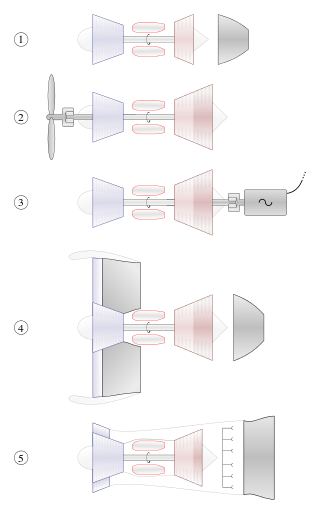
A gas turbine,gas turbine engine, or also known by its old name internal combustion turbine, is a type of continuous flow internal combustion engine. The main parts common to all gas turbine engines form the power-producing part and are, in the direction of flow:

The turbofan or fanjet is a type of airbreathing jet engine that is widely used in aircraft propulsion. The word "turbofan" is a combination of the preceding generation engine technology of the turbojet, and a reference to the additional fan stage added. It consists of a gas turbine engine which achieves mechanical energy from combustion, and a ducted fan that uses the mechanical energy from the gas turbine to force air rearwards. Thus, whereas all the air taken in by a turbojet passes through the combustion chamber and turbines, in a turbofan some of that air bypasses these components. A turbofan thus can be thought of as a turbojet being used to drive a ducted fan, with both of these contributing to the thrust.

The Rolls-Royce RB211 is a British family of high-bypass turbofan engines made by Rolls-Royce. The engines are capable of generating 41,030 to 59,450 lbf of thrust. The RB211 engine was the first production three-spool engine and turned Rolls-Royce from a significant player in the aero-engine industry into a global leader.

The Rolls-Royce Trent is a family of high-bypass turbofans produced by Rolls-Royce. It continues the three spool architecture of the RB211 with a maximum thrust ranging from 61,900 to 97,000 lbf . Launched as the RB-211-524L in June 1988, the prototype first ran in August 1990. Its first variant is the Trent 700 introduced on the Airbus A330 in March 1995, then the Trent 800 for the Boeing 777 (1996), the Trent 500 for the A340 (2002), the Trent 900 for the A380 (2007), the Trent 1000 for the Boeing 787 (2011), the Trent XWB for the A350 (2015), and the Trent 7000 for the A330neo (2018). It has also marine and industrial variants like the RR MT30.

The Rolls-Royce Turbomeca RTM322 is a turboshaft engine produced by Safran Helicopter Engines. It was originally conceived and manufactured by Rolls-Royce Turbomeca Limited, a joint venture between Rolls-Royce plc and Turbomeca. The engine was designed to suit a wide range of military and commercial helicopter designs. The RTM322 can also be employed in maritime and industrial applications.

The Turbo-Union RB199 is a turbofan jet engine designed and built in the early 1970s by Turbo-Union, a joint venture between Rolls-Royce, MTU and Aeritalia. The only production application was the Panavia Tornado.

The Rolls-Royce Olympus was the world's second two-spool axial-flow turbojet aircraft engine design, first run in May 1950 and preceded only by the Pratt & Whitney J57, first-run in January 1950. It is best known as the powerplant of the Avro Vulcan and later models in the Concorde SST.
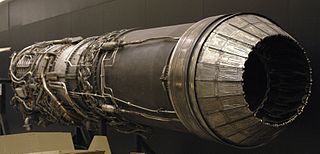
The General Electric J79 is an axial-flow turbojet engine built for use in a variety of fighter and bomber aircraft and a supersonic cruise missile. The J79 was produced by General Electric Aircraft Engines in the United States, and under license by several other companies worldwide. Among its major uses was the Lockheed F-104 Starfighter, Convair B-58 Hustler, McDonnell Douglas F-4 Phantom II, North American A-5 Vigilante and IAI Kfir.

The Pratt & Whitney J75 is an axial-flow turbojet engine first flown in 1955. A two-spool design in the 17,000 lbf (76 kN) thrust class, the J75 was essentially the bigger brother of the Pratt & Whitney J57 (JT3C). It was known in civilian service as the JT4A, and in a variety of stationary roles as the GG4 and FT4.
A microturbine (MT) is a small gas turbine with similar cycles and components to a heavy gas turbine. The MT power-to-weight ratio is better than a heavy gas turbine because the reduction of turbine diameters causes an increase in shaft rotational speed. Heavy gas turbine generators are too large and too expensive for distributed power applications, so MTs are developed for small-scale power like electrical power generation alone or as combined cooling, heating, and power (CCHP) systems. The MT are 25 to 500 kW (34 to 671 hp) gas turbines evolved from piston engine turbochargers, aircraft auxiliary power units (APU) or small jet engines, the size of a refrigerator. Early turbines of 30–70 kW (40–94 hp) grew to 200–250 kW (270–340 hp).

The Rolls-Royce AE 3007 is a turbofan engine produced by Rolls-Royce North America, sharing a common core with the Rolls-Royce T406 and AE 2100. The engine was originally developed by the Allison Engine Company, hence the "AE" in the model number.
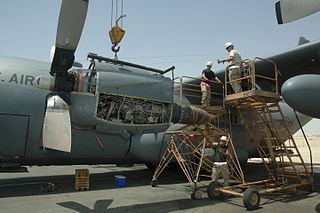
The Allison T56 is an American single-shaft, modular design military turboprop with a 14-stage axial flow compressor driven by a four-stage turbine. It was originally developed by the Allison Engine Company for the Lockheed C-130 Hercules transport entering production in 1954. It has been a Rolls-Royce product since 1995 when Allison was acquired by Rolls-Royce. The commercial version is designated 501-D. Over 18,000 engines have been produced since 1954, logging over 200 million flying hours.

The Rolls-Royce Trent 500 is a high-bypass turbofan produced by Rolls-Royce to power the larger A340-500/600 variants. It was selected in June 1997, first ran in May 1999, first flew in June 2000, and achieved certification on 15 December 2000. It entered service in July 2002 and 524 engines were delivered on-wing until the A340 production ended in 2012.

The Bristol Orion aero engine is a two-shaft turboprop intended for use in later marks of the Bristol Britannia and the Canadair CL-44. Although the engine was built and underwent a development program, the BE.25 Orion project was cancelled in 1958 by the British Ministry of Supply in favour of the Rolls-Royce Tyne. In addition, interest in turboprop-powered aircraft was beginning to wane, because of the successful introduction of the Boeing 707 and Douglas DC-8 jetliners into airline service.
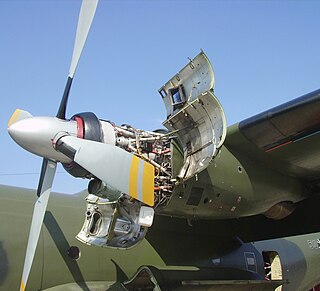
The Rolls-Royce RB.109 Tyne is a twin-shaft turboprop engine developed in the mid to late 1950s by Rolls-Royce Limited to a requirement for the Vickers Vanguard airliner. It was first test flown during 1956 in the nose of a modified Avro Lincoln. Following company naming convention for gas turbine engines this turboprop design was named after the River Tyne.

The Rolls-Royce RB.401 was a British two-spool business jet engine which Rolls-Royce started to develop in the mid-1970s as a replacement for the Viper. RB.401-06 prototype engines were already being manufactured when a decision to develop the higher thrust RB.401-07 was taken.

The General Electric YF120, internally designated as GE37, was a variable cycle afterburning turbofan engine designed by General Electric Aircraft Engines in the late 1980s and early 1990s for the United States Air Force's Advanced Tactical Fighter (ATF) program. It was designed to produce maximum thrust in the 35,000 lbf (156 kN) class. Prototype engines were installed in the two competing technology demonstrator aircraft, the Lockheed YF-22 and Northrop YF-23.

The Allison Model 250, now known as the Rolls-Royce M250, is a highly successful turboshaft engine family, originally developed by the Allison Engine Company in the early 1960s. The Model 250 has been produced by Rolls-Royce since it acquired Allison in 1995.

The Rolls-Royce Marine Olympus is a marine gas turbine based on the Rolls-Royce Olympus aircraft turbojet engine.
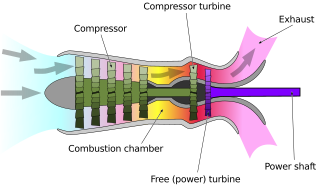
A free-turbine turboshaft is a form of turboshaft or turboprop gas turbine engine where the power is extracted from the exhaust stream of a gas turbine by an independent turbine, downstream of the gas turbine. The power turbine is not mechanically connected to the turbines that drive the compressors, hence the term "free", referring to the independence of the power output shaft. This is opposed to the power being extracted from the turbine/compressor shaft via a gearbox.